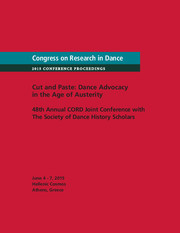No CrossRef data available.
Article contents
Embodying Classical Jazz Dance Technique: Gus Giordano's Dynamic Rewriting of the Female Dancer's Body
Published online by Cambridge University Press: 04 January 2013
Abstract
Jazz dance has come to be recognized as a serious and significant art form. Eventually, a path was forged by a few jazz dance pioneers who developed and codified their movement methodology and inscribed their styles on other dancers through training programs and choreography. Presently, Gus Giordano is one of four twentieth-century dance artists who are considered pioneer figures in systemizing jazz dance. This kinesthetic and detailed “reading” of elements of his technique will reveal how Giordano's fashioning of diverse cultural components has had an empowering effect upon the female dancer and enables us to make certain assumptions about how Giordano's technique affects her perception of herself and of her place in the world.
- Type
- Research Article
- Information
- Congress on Research in Dance Conference Proceedings , Volume 40 , supplement S1: Dance Studies and Global Feminisms , 2008 , pp. 203 - 213
- Copyright
- Copyright © The Author(s) 2008


